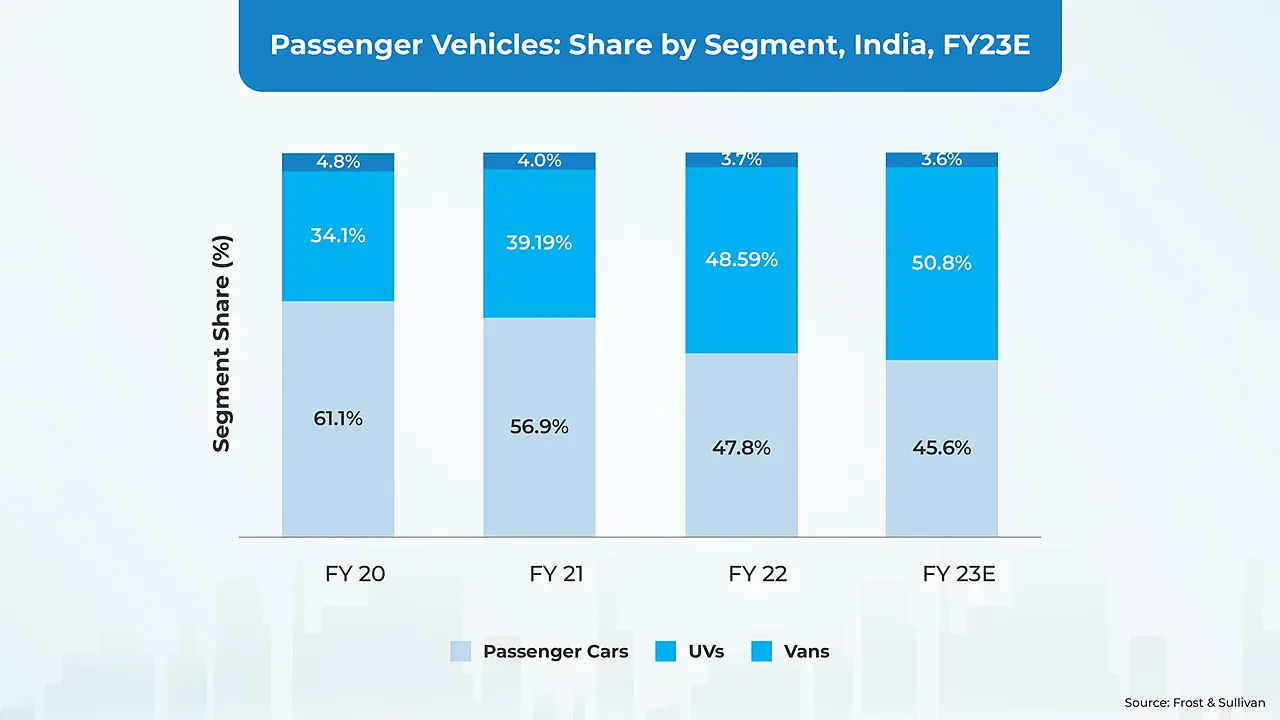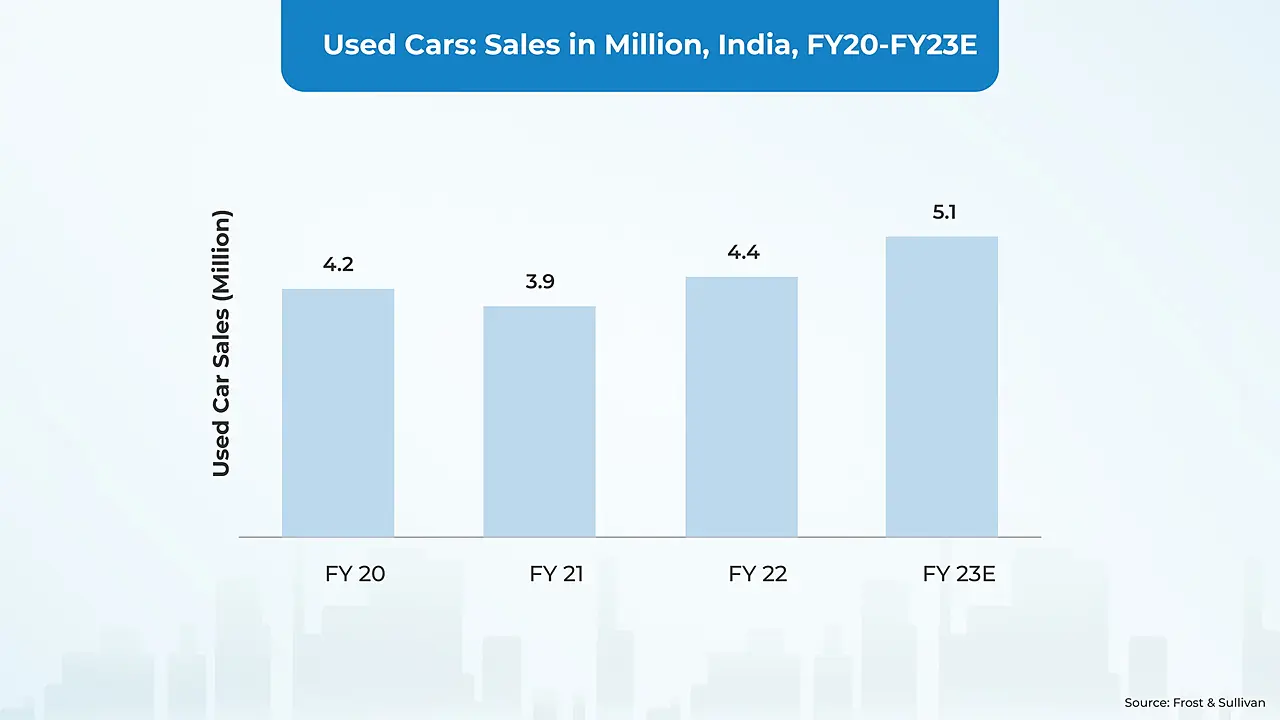
The Indian automotive industry is set to hit top gear in 2023. According to Frost & Sullivan’s India Passenger Vehicle Market Outlook, 2023, domestic sales grew by around 24% in FY23 due to pent-up demand, better than anticipated festive sales, new product launches by key OEMs, and robust uptake of utility vehicles (UVs).
Innovative technologies, new business models, and evolving customer expectations are invigorating the Indian passenger vehicle (PV) market. Over the next few years, Indian automakers will need to address regulatory and customer requirements related to emissions reduction as well as vehicle and road safety.
They will also need to focus on developing a wider range of cost-effective models while innovating with products and features aligned with customer expectations: alternate powertrains like CNG, hybrid and battery electric vehicles (BEVs), advanced driver assistance systems (ADAS), connected car technologies, and enhanced human machine interface (HMI).
Today, trends indicate surging demand for compact UV, UV1 and UV2 models. OEMs will need to consistently expand their model offerings in the UV segment to keep pace with intensifying competition. At the same time, in a market characterised by high price sensitivity, the used car segment will continue to boom.
Retail paradigms will transform as OEMs and traditional sellers aggressively pursue digital channels to reach a cohort of young, tech-savvy customers. Meanwhile, from online dealerships to virtual reality (VR) showrooms and new EV battery subscriptions, market stakeholders will adopt a range of new business strategies to grow their customer base.
Virtual showrooms will be driven by sophisticated new technologies that will change the way brands interact with their customers; no more will it be about a one-time, standalone purchase or just the product. Instead, it will become about continuous service provision and deepening customer experience and engagement.
Flurry of New Model, Technology Launches
Over the near term, a flurry of new model launches will characterise the high growth, compact UV, UV1 and UV2 segments. The competition will intensify as major global OEMs, such as Hyundai, Kia, Skoda, Volkswagen, and Renault, square-off against home-grown competitors with strong product portfolios like Maruti, Tata, and Mahindra.
In FY 2023, UVs became the largest-selling segment of India’s PV market, with around 51% of the market share. Demand for UVs has been spurred primarily by new, competitively priced product launches by all major OEMs in the compact UV and UV1 segments.

Stricter emission regulations, new model launches, and significant spikes in petrol and diesel prices combined to boost the share of alternative powertrains like CNG and hybrids in FY23. Expanding CNG networks, changing customer preferences, the introduction of factory-fitted CNG powertrain options in new and existing vehicle models, and the implementation of real driving emissions (RDE) norms will result in the share of such alternative powertrain options growing over the next 2-3 years.
Supported by new model launches and a raft of Central and State Government incentives and subsidies, sales of battery electric vehicles (BEVs) more than doubled in FY23 compared to FY22. EV sales will be reinforced by expanding charging infrastructure networks in the coming years.
Consistent increases in new vehicle prices and higher cost of ownership will provide a fillip to used car sales. Positive trends like the rising presence of organised channel players, improved asset quality, and broader finance options are underlining the growing appeal of used cars. India’s used car market reached 5.1 million units in FY23, growing at approximately 16% as compared to FY22.

Another emerging trend in the Indian PV market relates to ADAS. OEMs are spearheading such initiatives in a bid to achieve competitive differentiation, albeit Level 2 ADAS features are currently on offer only in certain high-end vehicles. Over the next 3-5 years, mass market penetration of basic ADAS features is expected, impelled by government mandates about the use of certain ADAS features to enhance passenger safety.
OEMs will also seek to embrace connected car technologies to showcase their capabilities and achieve competitive differentiation. Accordingly, the focus will be on offering fully digital instrument clusters, larger advanced infotainment systems, heads-up displays, and AI-based voice assistants.
While touch features will continue to have a central role to play in HMI solutions, OEMs will look beyond touch to more multimodal options. With the aim of improving customer convenience and safety, they will introduce haptics and voice assistants.
Automotive retail will undergo a dramatic transformation with the use of AR/VR, gamification, AI-based sales assistants, and virtual test drives. Advanced interactive technologies will be leveraged to realise end-to-end digitisation of the vehicle purchase process.
The Indian PV market offers exciting long-term growth potential based on current low penetration rates. OEMs – foreign and domestic – are creating India-focused offerings as they seek to boost penetration rates and tap into increased demand from Tier II/III cities and rural areas.
Tapping Into Opportunities
Like elsewhere globally, UVs, along with their sub-segments, will dominate India’s automotive landscape. To leverage such trends, OEMs should design varied vehicle purchase packages backed by attractive finance schemes and low-interest rates. They should also build products and services that specifically target the massively underpenetrated rural customer segment.
An overwhelming majority of Indian car buyers are convinced about the criticality of vehicle connectivity. OEMs will, therefore, need to focus on incorporating connectivity-enabled safety and security, infotainment, commerce, and remote assistance services, among other smart functionalities, in their vehicles.
This will emphasise the importance of cross-industry collaborations between the automotive industry and sectors like IT, healthcare, and insurance. Such convergence will create a new value chain anchored in multiple monetisation possibilities, such as, for instance, usage-based insurance.
ADAS penetration is expected to increase in the next 2-4 years, driven by both OEM and customer interest. Success will derive from the ability to offer ADAS features as customisable packages so that the customer pays for only the features they want, partner with technology companies and suppliers to develop cost-effective solutions and create offerings that address Indian driving environments.
OEM portfolio expansion will be crucial to capitalise on the demand for alternate fuel vehicles. Partnerships with financial institutions and localisation of vehicle and component production will be vital to controlling costs and making EVs more accessible.
Greater customer receptivity towards EVs and OEM emphasis on portfolio electrification notwithstanding, the development of enabling charging infrastructure will be a springboard to drive growth in India’s electric PV market. To this end, it will be incumbent on charging point operators (CPOs) to rapidly build their networks in the next 1-3 years.
About the Author: Seshasayee Tatineni is Industry Analyst – Mobility with Frost & Sullivan. He has seven years of research and consulting experience, focusing on passenger cars, two-wheelers, electric vehicles, connectivity, ADAS, EV charging, and auto components.
Also Read

